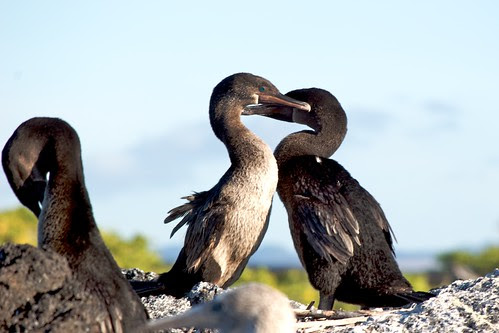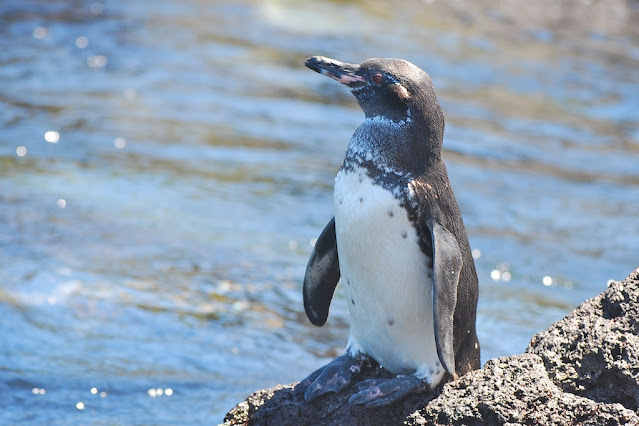The Recent Origin of the Islands
 |
| Signs of recent volcanic activity appear on many islands. Here, you can see a lava tube with both of the major types of lava: a’a and pahoehoe. |
 |
| A crevasse in the ground: another sign of recent volcanic activity. |
 |
| We enjoyed all these beautiful volcanic landscapes during our voyage from August 17-24. |
Life Begins on the Isolated Island
Five million years is very brief in geological time! The new islands, being very far from the South American continent, had no life forms at first. Slowly, birds landed on the island, some blown by storms, many by flying there on their own. Plants and small creatures arrived from the mainland on large floating tangles of branches and roots; birds also can carry seeds or insects on their feet or feathers. In time, these new residents adapted in ways that haven’t really been observed in other places.
During the last 300 years, humans have been frequent visitors, and a small number of people eventually settled in the Galapagos. The current population is around 32,000. With human activity, some native species have become extinct, and other species have been introduced such as goats and rats. Recently, the fascinating variety of birds, iguanas, giant tortoises, plants, and so on have become a major attraction for tourists.
From our own photos, here are a few images of the very numerous endemic species in the Galapagos taken during our two trips to the islands in 2010 and 2024.
 |
| Flightless cormorants, unique to the Galapagos (2010) |
 |
| Endemic Lava Gulls, rarest gulls in the world. |
 |
| Around 18 species of finches are found only on the Galapagos Islands. Here’s one example. |
 |
| A giant tortoise at the Darwin Research Station |
 |
| Galapagos Sea Lions, another endemic species that we have seen on many islands. |
 |
| Marine Iguanas — perhaps the strangest of the endemics in the Galapagos. Darwin called them “Imps of Darkness.” |
 |
| Sallylightfoot Crabs are everywhere on the rocky shore; they are also found in many other locations. |
 |
| I don’t know anything about plants, but this is one of the evolved plants that is unique to the Galapagos. |
Charles Darwin and the Study of Natural Selection
 |
| Len and Darwin at the Darwin Research Station. |
In 1835, Charles Darwin spent several weeks visiting some of the islands in the Galapagos, which were at that time uninhabited by humans. He was traveling as a naturalist and companion to the captain of the ship H.M.S. Beagle, whose purpose was to make nautical charts and collect native species of plants and animals. His work was eventually published under the long title:
On the Origin of Species
BY MEANS OF NATURAL SELECTION, OR THE
PRESERVATION OF FAVOURED RACES IN THE STRUGGLE FOR LIFE.
You are probably aware of the history of Darwin’s careful observations and life-long effort to understand how the emergence of the unique plants and animals of the Galapagos as well as the species found in many other places he visited. You probably also know of the controversies about his theories and their eventual acceptance by scientists and natural historians. Many ensuing research projects in the scientific fields that Darwin invented have and vindicated Darwin’s accomplishments.
 |
| One evening we cruised past the island of Daphne Major while hearing a talk about an important project done there. |
Daphne Major was the site of some very important research to understand natural selection in action. From 1973 until 1989 two evolutionary biologists, Peter and Rosemary Grant, lived there and intensively studied the various species of finches on the island. They and their students discovered many new details about natural selection and speciation in the birds they observed. Their work was the subject of an award-winning book titled The Beak of the Finch by Jonathan Weiner.
I read Weiner’s book some time ago, and I was very interested in seeing the actual island that was involved, though from the deck of the ship one can’t actually see the flat volcanic mountain top where the birds and researchers lived. While we were traveling on the ship I borrowed the somewhat dog-eared copy of the book from the ship’s library and began reading it again. (Having a carefully selected library of natural history, geography, and biology books is a key amenity of Natural Geographic voyages!)
More about the Island’s History
For a brief history of the islands and of Darwin’s visit see this summary from the Galapagos Conservancy.
The human history of the islands is very brief: in the 1960s there were only 2000 residents, and today there are only 32,000. A few settlements date from the early 20th century, and the airport on Baltra Island was built as an American base during World War II.
The inhabitants today mainly work in the tourist industry, with a very small amount of agriculture and fishing. Needless to say, many volumes of history, scientific research, and accounts of natural history chronicle the fascinating story of the islands.
Blog post and photos © 2010, 2024 mae sander






Wonderful post on the history of the Galapagos islands, the native species and the landscapes. Great collection of photos. Take care, enjoy your day and have a great week ahead.
ReplyDeleteThanks! I enjoyed this overview. I always think of Darwin and the creatures that are found there, but it is interesting to learn more about the geological history of the place itself.
ReplyDeleteIt seems hopeful to me that so many people are interested in seeing this unique place in the world that tourism is a major industry. I did not know any of the geological history of the Galapagos Island, so I thank you for sharing it with us.
ReplyDeleteVery interesting and all those animals. The tortoise is... WOW.
ReplyDeleteMy Dad waaaay back then only sent a postcard. No pics, no stories,so: Thank you very much!
This is so interesting, Mae. I know nothing about that part of the world. Your descriptions and background are so clear and easy to follow.. And you can't deny the beauty.
ReplyDeleteInteresting post and photos.
ReplyDeleteFantastic post! The Galapagos Islands is a unique and fascinating place. The photos are incredible.
ReplyDeleteWonderful post on the unique Galapagos wildlife. The tortoise is amazing, I am happy they are being bred at the research station.
ReplyDeleteGreat collection of photos. Thank you for linking up and sharing your post. Take care, have a wonderful weekend. PS, thank you for leaving me a comment.
Thank you. I am so sad my Dad id not around anymore - he would´ve LOVED this!!! A great, interesting post. My two police horses sure "stink off",LOL.
ReplyDeleteI'm catching up but was really interested in this post. It looks so amazing. I'm not surprised they are still volcanic active, but I didn't know that they were. I wonder how those islands will evolve geologically.
ReplyDeleteThe penquin is adorable! I know you must have enjoyed researching and then actually visiting this amazing place. It really is special!
ReplyDeleteWonderful post! Your trip looks amazing and you’ve really provided some interesting and beautiful photos. Thanks for sharing.
ReplyDelete